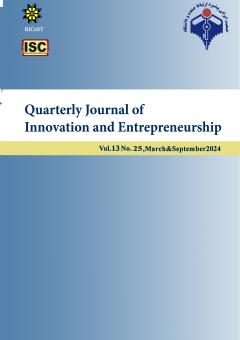Studying the Relationship of the Following Concepts- Creative Industries, Cultural Industries and Creative Cultural Industries- and the Concept of Media: Toward a Theoretical Integrity
Subject Areas : Special
Nafiseh Ansari
1
![]() ,
mahdi sharifi
2
,
mahdi sharifi
2
![]() ,
Majid Mokhtarianpour
3
,
Majid Mokhtarianpour
3
![]() ,
Marjan Fayazi
4
,
Marjan Fayazi
4
![]()
1 - Ph.D. student, Department of Media Management and Business Communication, Faculty of Business Management, College of Management, University of Tehran, Tehran, Iran
2 - Associate Professor, Department of Media Management and Business Communication, Faculty of Business Management, College of Management, University of Tehran, Tehran, Iran
3 - Assistant Professor, Department of Public Policy Making and Administration, Faculty of Public Administration and Organizational Sciences, University of Tehran, Tehran, Iran
4 - Associate Professor, Department of Leadership and Human Capital, Faculty of Public Administration and Organization Science, University of Tehran, Tehran, Iran
Keywords: Creative Industries, Cultural Industries, Media, Culture Industry, Comparative Study,
Abstract :
The classification of media as either creative or cultural industries has long been a subject of contention. Some advocate for labeling them as creative, while others insist on their categorization as cultural. Additionally, there are those who opt for the term "creative and cultural industries," and others who advocate for "creative cultural industries." Often, these designations are made without a comprehensive understanding of the commonalities and distinctions between these concepts. Using a comparative method, this study aims to explore the principal approaches and models of creative and cultural industries - encompassing 19 models - to assess the suitability of each of these concepts - "creative industries," "cultural industries," "cultural creative industries," and "creative cultural industries" - in elucidating the concept of "media." These approaches are synthesized through an examination of reliable scientific sources such as articles, books, and international reports. The findings indicate that cultural industries invariably entail creativity, whereas the converse is not always true; that is, creative industries may occasionally exhibit considerable cultural elements, while at other times they may lack such attributes. Therefore, it is inaccurate to universally apply the label of cultural industries to all creative industries and to equate cultural industries with creative ones. However, media, being an integral component of cultural industries, can be aptly referred to as "creative industries" and "cultural and creative industries," with these terms being interchangeable in the context of media
1. تراسبی، د. (1387). اقتصاد و فرهنگ. (کاظم فرهادی مترجم).تهران: نشر نی (نشر اصلی اثر 2001).
2. تراسبی، د. (1393). اقتصاد سیاست فرهنگی. (سوسن علایی مترجم). تهران: انتشارات سوره مهر (نشر اصلی اثر 2010).
3. درزی، ق. (1402). مطالعه تطبیقی میانرشتهای قرآن و عهدین، گونهها و نمونهها. نشریه تحقیقات علوم قرآن و حدیث، 57، 25–42.
4. شریفی، س. م.،محمدی، ح. ع.، و انصاری، ن. (1397). مدیریت منابع انسانی در صنایع خلاق. انتشارات مدیریت صنعتی.
5. محمدی،م.، حاجی¬ زاده،پ. و کمالیان، ی. (1397). سازمان صنایع خلاق. پژوهشکده سیاست¬پژوهی و مطالعات راهبردی حکمت.
6. Baeker, G. (2017). cultural economies What Are They and How Do We Build Them? Economic Development Journal, 16(2), 37–43.
7. Banks, M. (2007). The Polotics of Cultural Work. In the Open University. Palgeave Macmillan.
8. DCMS. (1998). Creative Industries Mapping Document. National Statistics on the Creative Industries.
9. DCMS, Statman, M., & Glushkov, D. (2016). Classifying and Measuring the Creative Industries. Journal of Portfolio Management, 42(2), 140–151.
10. Denatale, D., & Wassall, G. H. (2007). The Creative Economy: A New Definition (p. 64). NEW England Foundation for the Art (nefa).
11. Department of Culture, media and sports. (2016). Creative Industries Economic Estimates\Methodology.
12. ESSnet-CULTURE. (2012). European Statistical System Network on Culture - Final Report. In EssnetCulture.
13. Galloway, S., & Dunlop, S. (2007). A Critique of Definitions of The Cultural and Creative Industries in Public Policy. International Journal of Cultural Policy, 13(1), 17–31.
14. Garnham, N. (2005). From Cultural to Creative Industries. International Journal of Cultural Policy, 11(1), 15–29. https://doi.org/10.1080/10286630500067606
15. Hartley, J. (Ed.). (2005). Creative Industries. Blackwell Publishing.
16. Hartley, J., Potts, J., Cunningham, S., Flew, T., Keane, M., & Banks, J. (2013). Key Concepts in Creative Industries. Sage.
17. Heng, T. M., Choo, A., & Ho, T. (2003). Economic Contributions of Singapore’s Creative Industries. Economic Survey of Singapore, First Quarter, 51–75. http://www.ico-d.org/database/files/library/singapore.pdf
18. Hesmondhalgh, D., & Baker, S. (2011). Creative Labour. Routledge.
19. Johnson, T. G. (2019). Existing Conceptual Models of Arts and Culture: An Inventory (p. 48). Rural Policy Research Institute.
20. Jowell, T., & Hutton, W. (2007). Staying ahead : the Economic Performance of the UK ’ s Creative Industries. In The work foundation (pp. 1–280).
21. KEA. (2006). The Economy of Culture in Europe: Study prepared for the European Commission (Directorate-General for Education and Culture). European Commission.
22. O’Brien, D. (2014). CULTURAL POLICY. In Routledge.
23. O’connor, J. (2011). The Cultural and Creative Industries: A Critical History. Ekonomiaz, 24–44.
24. O’Connor, J. (2007). The cultural and creative industries: a review of the literature. In Creative Partnerships London.
25. PEC. (2022). National Statistics on the Creative Industries. Creative Industries Policy & Evidence Centre. https://pec.ac.uk/news/national-statistics-on-the-creative-industries.


